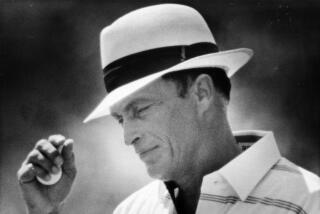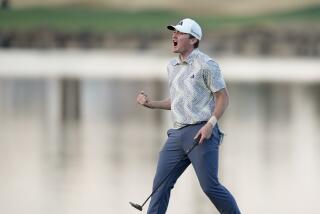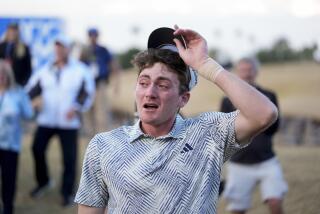A Regal Bearing
ST. ANDREWS, Scotland — From the road alongside the 18th green of the Old Course, from the grandstands, from windows and balconies and rooftops, applause cascaded upon Jack Nicklaus, a 65-year-old golf legend playing his last round in a major championship.
It ended, appropriately, with a long birdie putt, a wave to the fans and, after he wiped away tears, a short walk up the steps of the weathered, gray, stone clubhouse of the Royal and Ancient Golf Club of St. Andrews, cheers still reverberating off its darkly tinted windows.
At exactly 6 p.m. here Friday, the Nicklaus era ended in professional golf. He shot even-par 72 but missed the cut in his 38th British Open, a tournament he played for the first time in 1962. Nicklaus had said the Open Championship would be his last tournament, but he has hinted he might play again at his own tournament, the Memorial, held at his home course in Dublin, Ohio.
The throng of spectators for Nicklaus’ farewell spilled over the back of the green, where his family looked on. If it was a going-away party, it was a Nicklaus family affair. One of his sons, Steve, caddied for him, and savored the moment.
“I know he hates to say goodbye, but you’ve got to say goodbye sometime,” Steve said.
Nicklaus’ wife, Barbara, two more of his sons, Gary and Jackie, and his daughter, Nan, greeted him as he left the 18th green.
“I sort of let my emotions go,” he said. “The people were fantastic. Actually, as I was coming down the last few holes, I’m saying, ‘Man, I don’t want to go through this again. Maybe it’s just as well I miss the cut.’
“I think these people have been wonderful. They’ve given of themselves and gave me a lot more than I deserved. I’m probably better off getting out of here. Obviously, I kept trying to do the best I could.”
It was a warm and respectful reception for Nicklaus, much like what Arnold Palmer received when he made his final appearance at the British Open, at the Old Course in 1995.
Nicklaus covered the same ground Palmer did then, even stopping to pose for photographs as he crossed the ancient Swilcan Bridge on the 18th hole. The link between Palmer, who rose to stardom in the 1950s, and Nicklaus, who came on in the ‘60s, is strong, beginning when they were rivals, when Nicklaus succeeded Palmer as the dominant player of his generation.
“Jack’s given a lot to the game of golf,” said Phil Mickelson, ranked fourth in the world. “I think it was the team effort of the rivalry with Jack and Arnold that propelled golf. I don’t think one could have done it without the other.
“To play championship golf the way Jack and Arnie did it just made for great theater. The majors he has won has inspired a lot of players.”
Nicklaus’ place in the pantheon of golf’s greatest players is secure because of his record in the sport’s biggest tournaments. His 18 major professional titles are seven more than Walter Hagen’s second-place total. Ben Hogan, Gary Player and Tiger Woods are next, with nine.
Woods said he was honored to be included in any comparison with Nicklaus.
“He’s the greatest champion that’s ever lived,” Woods said. “He’s been the benchmark for every player that’s ever played the game, at least in my generation. Before him, it was probably Bobby Jones.”
Nick Faldo, a three-time British Open champion, said Nicklaus is unique.
“Jack was my inspiration. I watched him on TV in 1971 and I asked my parents if I could try golf, and here I am now,” Faldo said. “Jack has done his bit. Words are not really enough for Jack. They should make him out of gold and stick a little Jack on every tee box.”
Woods this week is attempting to join Nicklaus as the only players to have won all four majors at least twice. Nicklaus won each of the four at least three times, including a record six Masters. He won the PGA Championship five times, the U.S. Open four times and the British Open three times.
The record will show that Nicklaus could have had even more -- he was second in 19 majors.
At the British Open alone, Nicklaus was second seven times. In an 18-year span from 1963 through 1980, he had 17 top-six finishes in the British Open.
His PGA Tour victories number 73 -- his first the 1962 U.S. Open; his last the 1986 Masters. Sam Snead is at the top of the victory list with 82. Nicklaus shares with Palmer the record for consecutive years -- 17 -- winning at least one tournament.
He finished in the top 10 in 243 of 357 PGA Tour events from 1962 to 1979, and from 1971 to ’73 he had 41 top 10s in 55 events, with 19 wins and seven seconds.
Eight times Nicklaus led the PGA Tour in scoring average and he was also runner-up six years. He was the top money winner eight times and earned $5.7 million, not an overpowering total since his career did not coincide with the boom in tournament purses.
In Nicklaus’ greatest seasons, 1971 and 1972, the total prize money for either year did not exceed $8 million. Last year, $252 million was awarded at tournaments on the PGA Tour.
Before he started cashing checks as a pro, Nicklaus was a dominant amateur, winning the U.S. Amateur twice. He was 20 when he finished second to Palmer in the 1960 U.S. Open at Cherry Hills. The next year he turned pro, and he joined the PGA Tour in 1962.
Nicklaus also earned a reputation as a hard-edged match-play team player as a member of six Ryder Cup squads. He also served twice as Ryder Cup captain and three times has been captain of the Presidents Cup, which is played between the U.S. and an international team comprising players other than Europeans.
Off the course, Nicklaus reached a level of success in business dealings that mirrored his achievements as a player. Nicklaus and Palmer became the cornerstones of entrepreneur Mark McCormack’s sports marketing venture that grew into International Management Group.
Nicklaus has created a business model built around a golf course design company that generates an annual estimated income of $10.2 million, far behind the $83 million estimated annual endorsement and appearance fee income of Woods.
Nicklaus Design, which includes Nicklaus, sons Steve, Gary and Michael and son-in-law Bill O’Leary, has 281 golf courses open for play. Nine courses opened last year and 25 more are on schedule to open this year. Nicklaus himself is involved in 14 of those 25 projects.
“My competitive desire really runs in design,” he said. “I enjoy the design work from the standpoint that [in] your golf game you leave a legacy and your design work on the ground, you actually leave another legacy. You leave something for people to understand a little bit of what you thought about the game of golf or how it should be changed.”
The Nicklaus name retains cachet, even as the player fades. It is enough of a draw to attract Hall of Fame golfer Amy Alcott from Santa Monica to watch Nicklaus play his final major.
Alcott, who booked a room in the Old Course Hotel, recalled the advice Nicklaus gave her when she was 17 and considering turning pro straight out of Palisades High School.
“His advice was to go to college first,” Alcott said. “I’m glad I didn’t heed that advice from my hero. Many years later, when I was inducted into the World Golf Hall of Fame, we had a laugh on that.
“He was such a big influence on my golfing career as a young girl. I’m sure I’m not the only one.”
In 1950, Kaye Kessler was a sportswriter at the Columbus Citizen in Ohio and one day drove to Scioto Country Club to meet the new professional, Jack Grout, who suggested a story about the club’s junior program. Grout said one of the kids, a 10-year-old, could really play.
It was Nicklaus, who, in the club’s first junior tournament, shot a 51 for the first nine holes he ever played.
Kessler walked the Old Course this week and watched Nicklaus play, studying the familiar stooped putting style and a still-fluid swing. He couldn’t help but be reminded of the 10-year-old he first saw 55 years ago.
“He was awesome,” Kessler recalled. “You could just see he had it, the confidence, the determination, everything. You just knew he was going to be something. And I’m not sure we’ll see anything like him again.”
*
(BEGIN TEXT OF INFOBOX)
Bear facts
A look at Jack Nicklaus’ performances in the four majors. His first year on the PGA Tour was 1962.
(Text of Infobox not included)
*
By the Numbers
18
Major championships won (seven more than any other golfer).
*
19
Runner-up finishes in major championships.
*
5.7
In millions of dollars, total amount won in his PGA Tour career.
*
17,500
His winning check at the 1962 U.S. Open, his first professional victory, at age 22. (First place was worth $15,000, but he earned a $2,500 bonus for the playoff with Arnold Palmer.)
*
46
Age when he won the 1986 Masters, his final PGA Tour victory.
*
17
Consecutive years with at least one tournament victory, tied for most with Arnold Palmer.
*
24
Years between his first major championship (1962 U.S. Open) and his last major win (1986 Masters).
More to Read
Go beyond the scoreboard
Get the latest on L.A.'s teams in the daily Sports Report newsletter.
You may occasionally receive promotional content from the Los Angeles Times.










